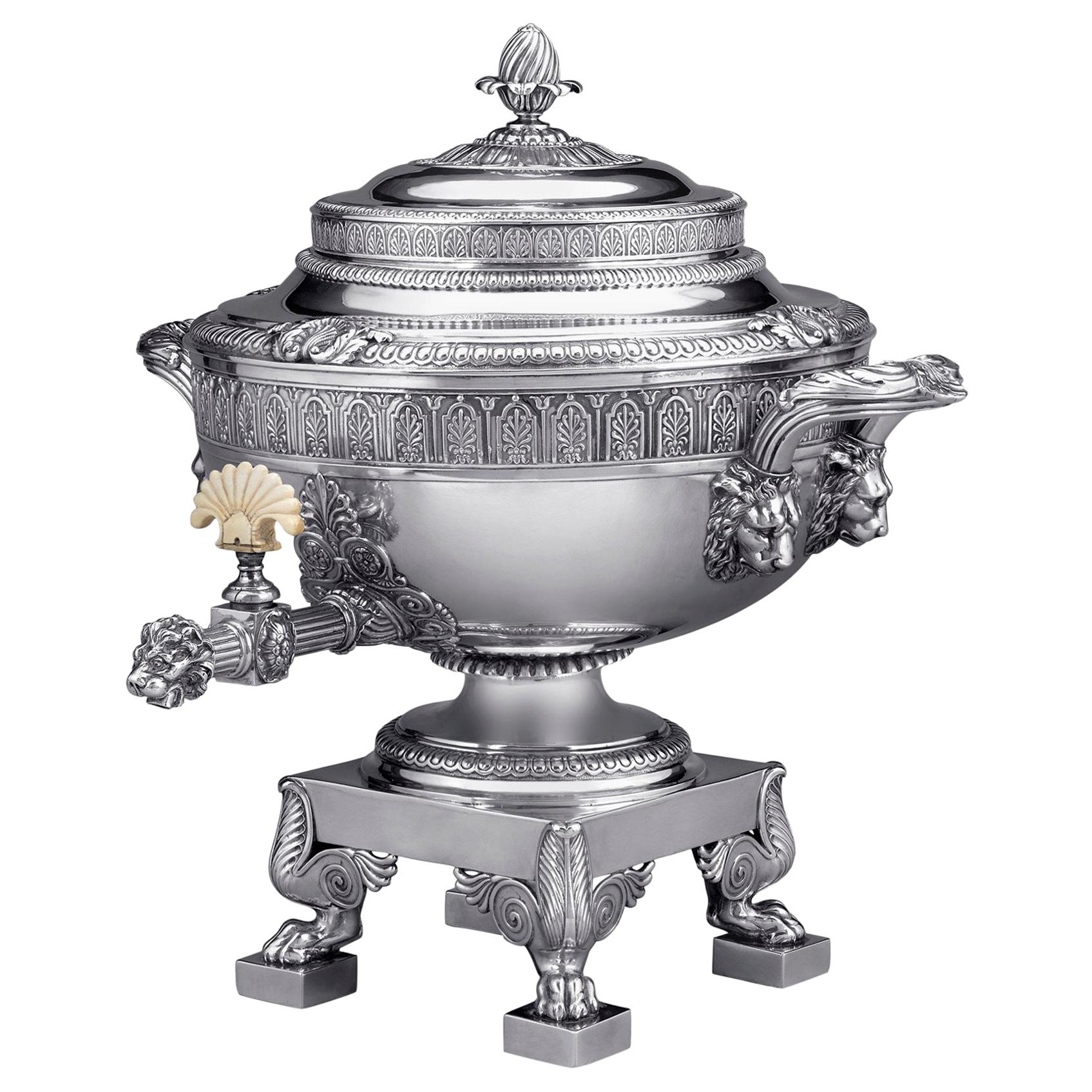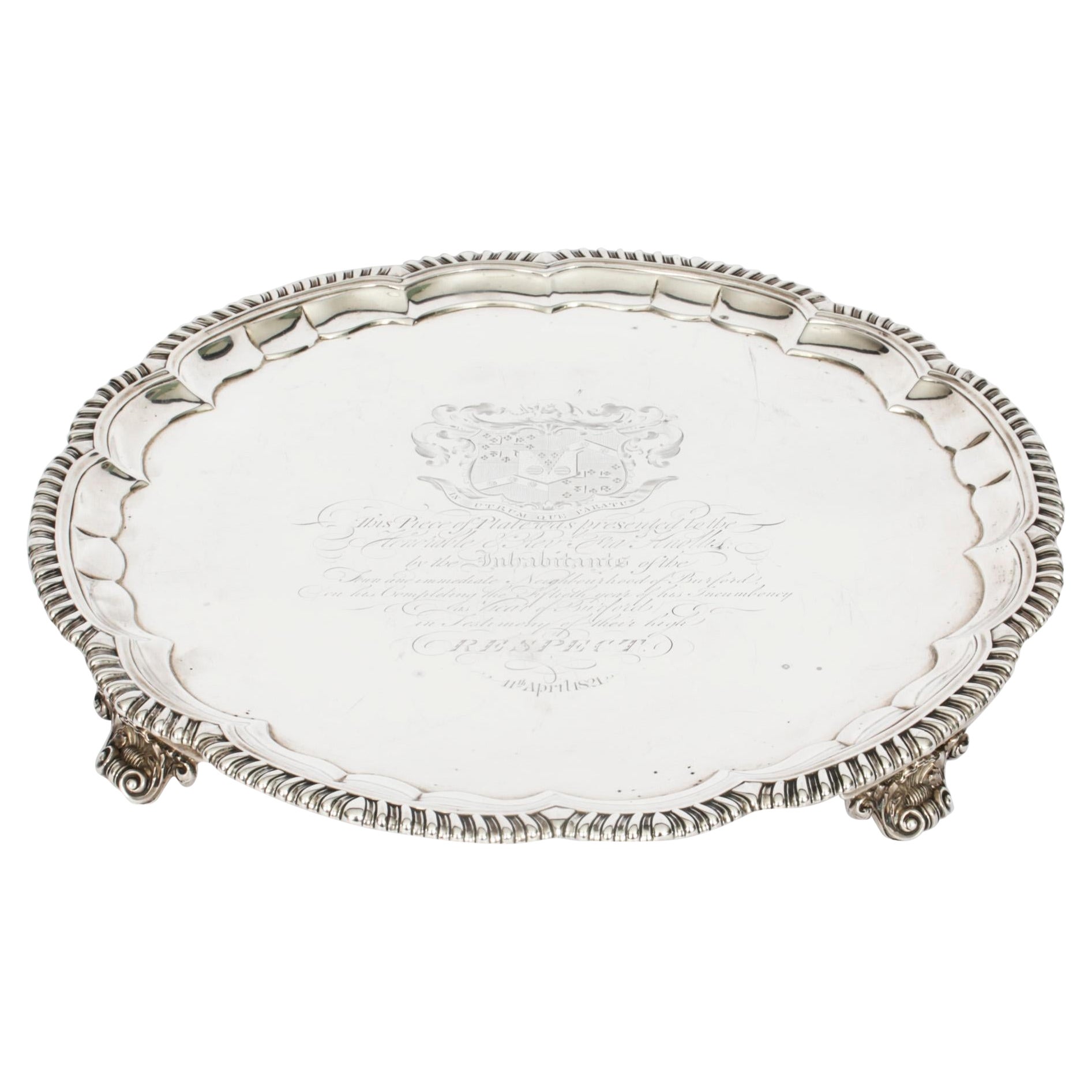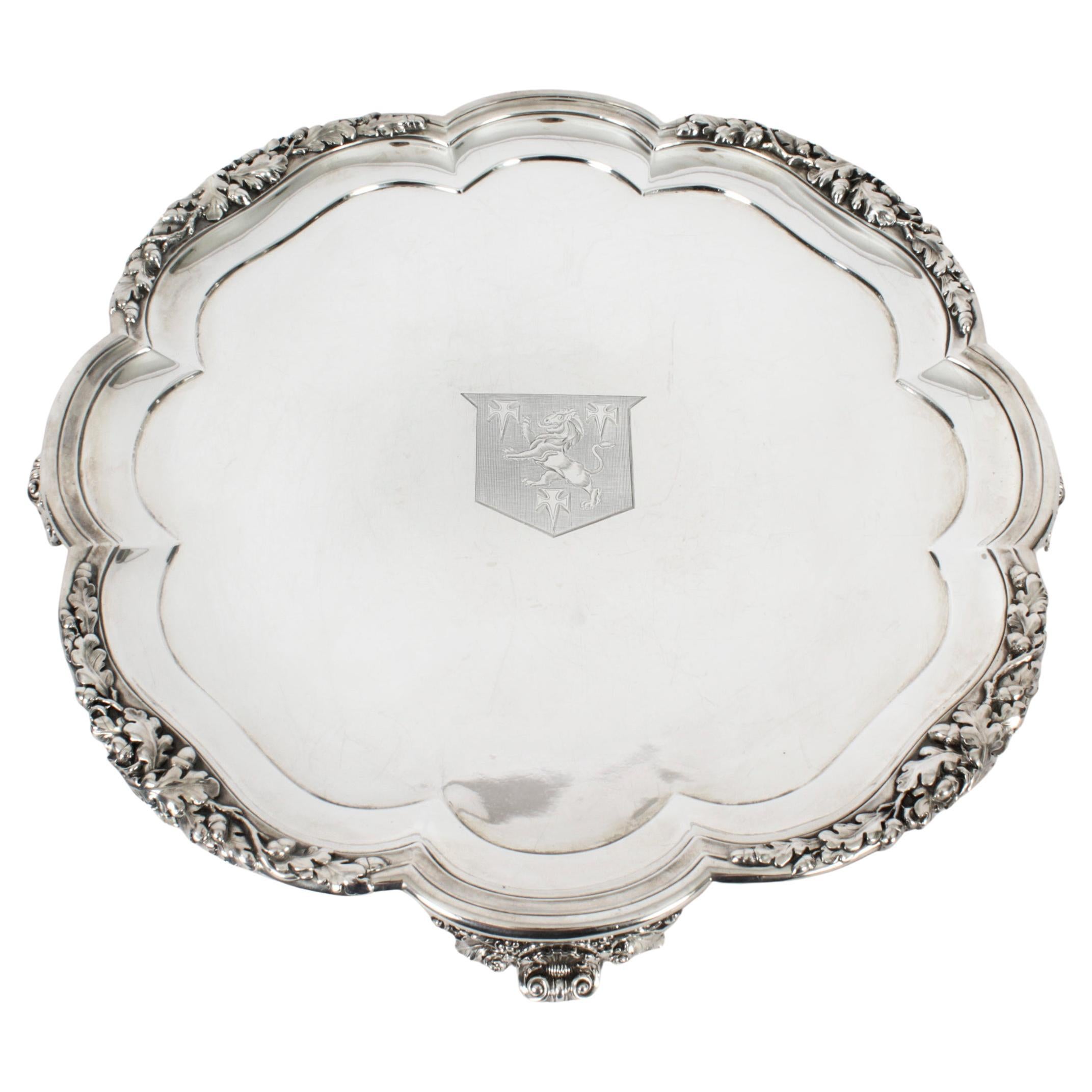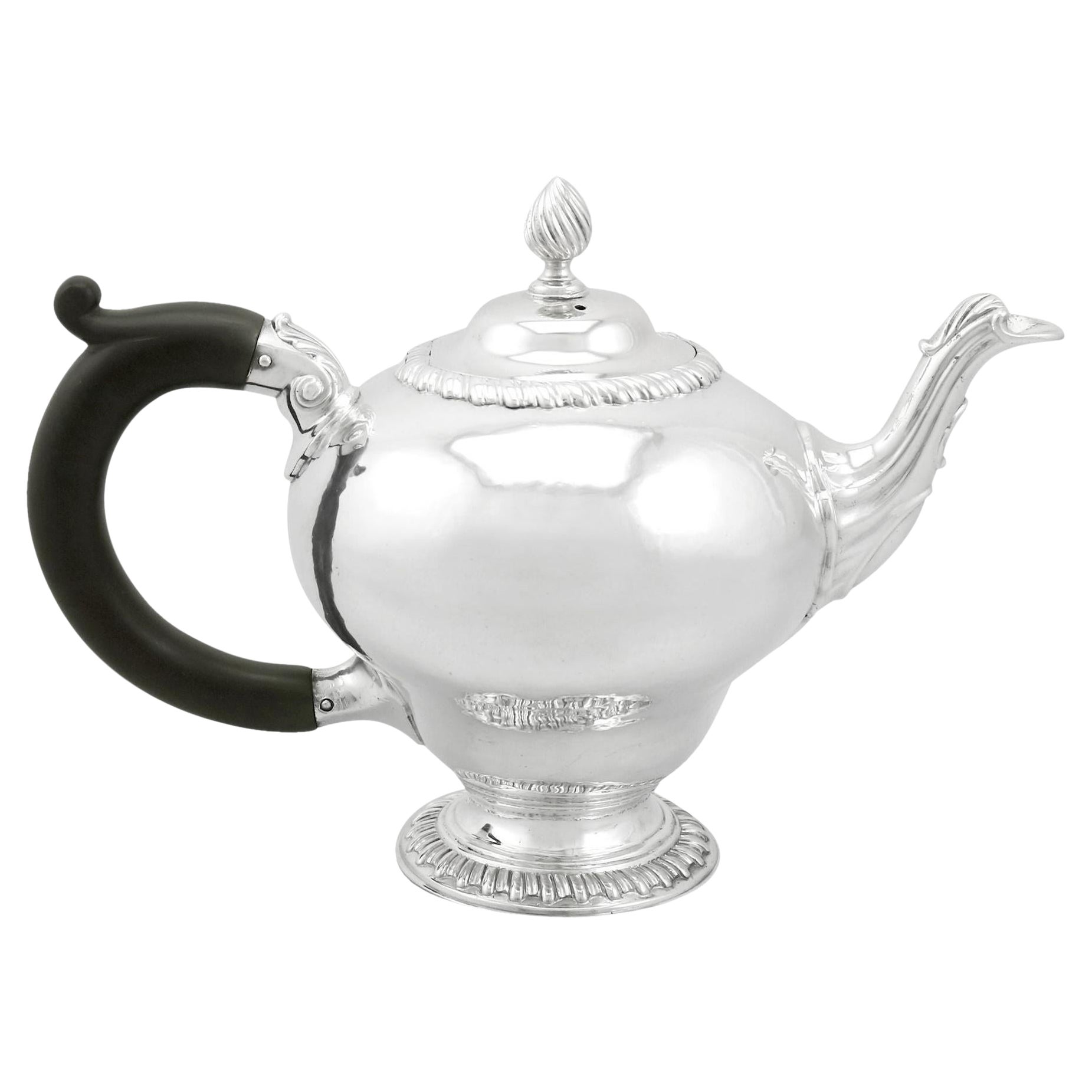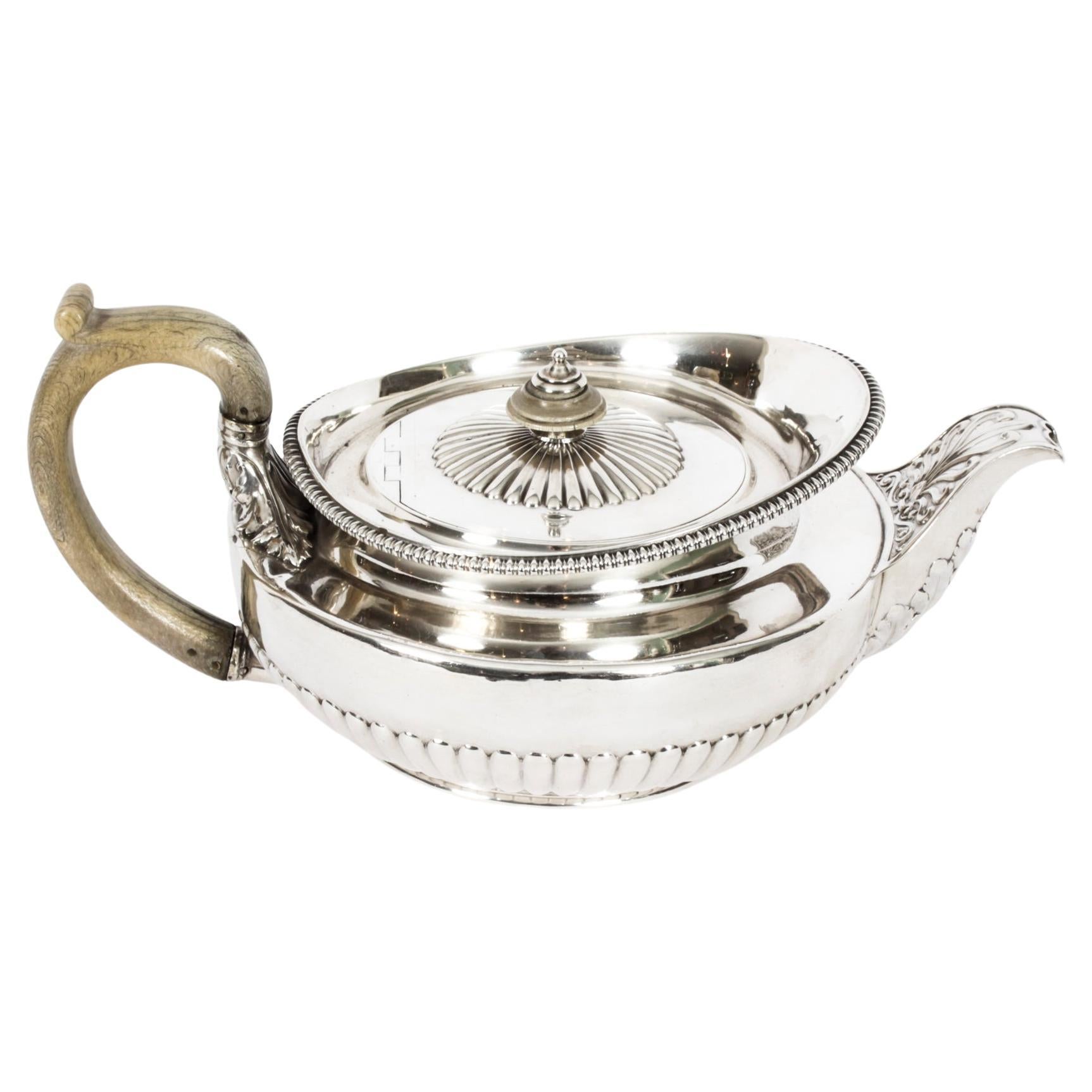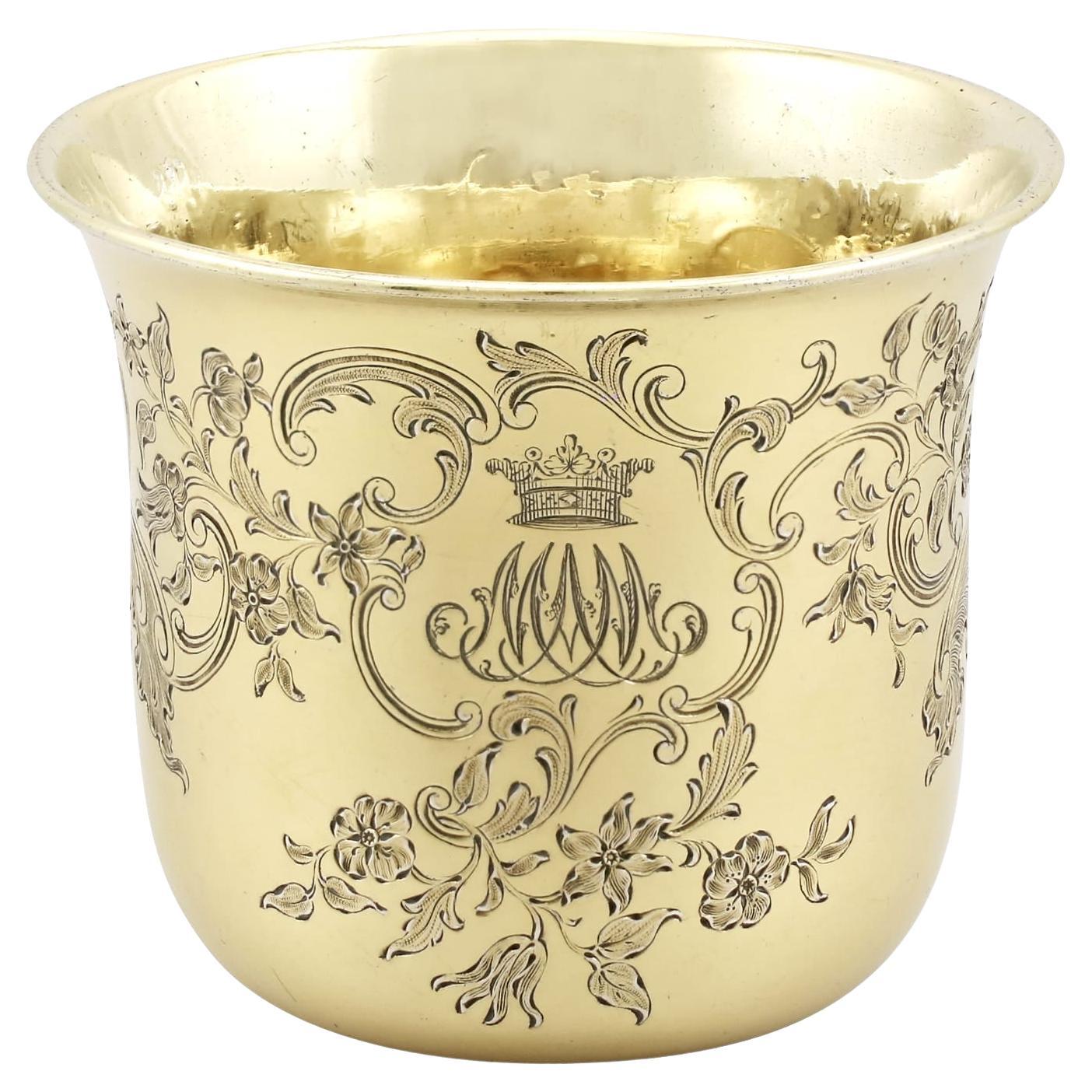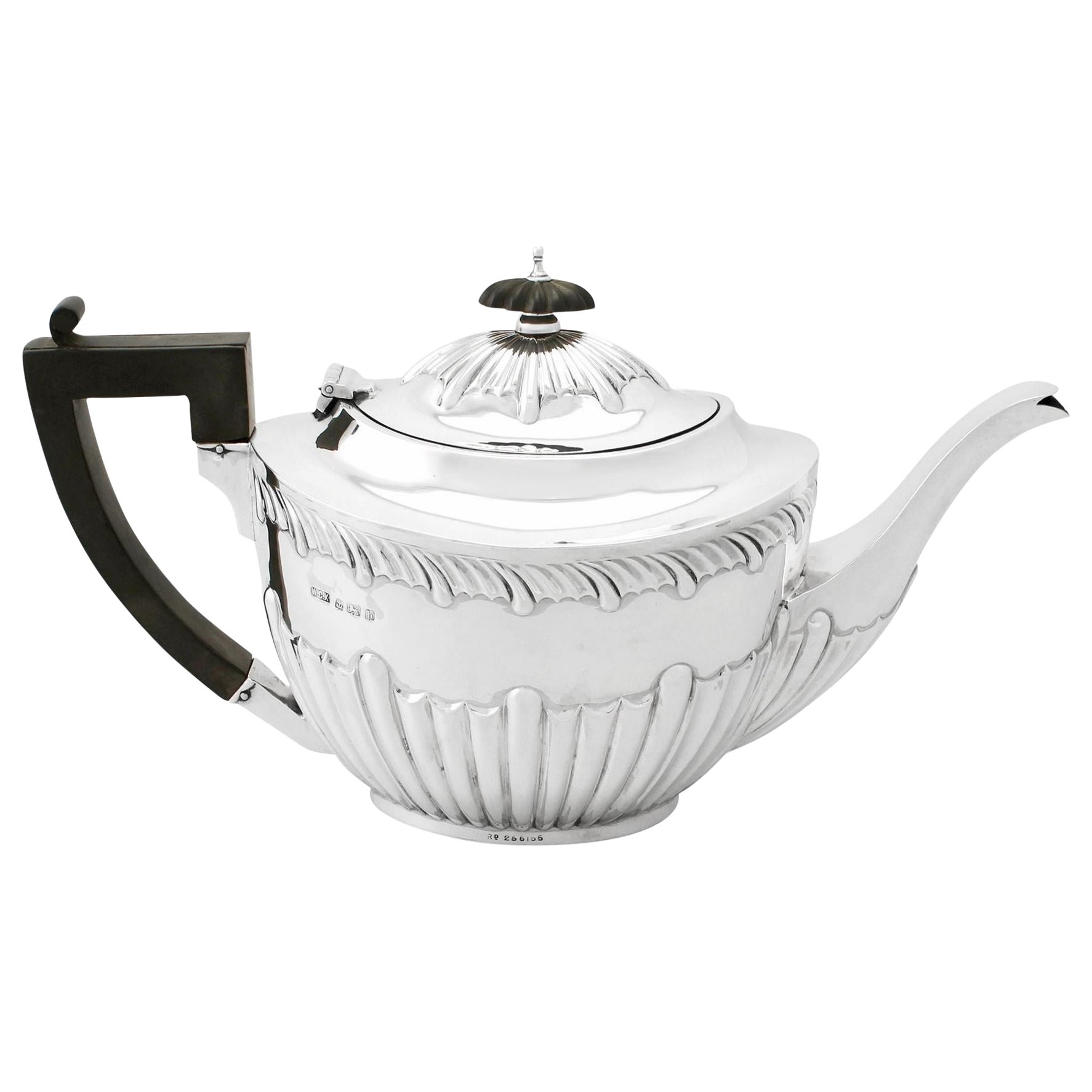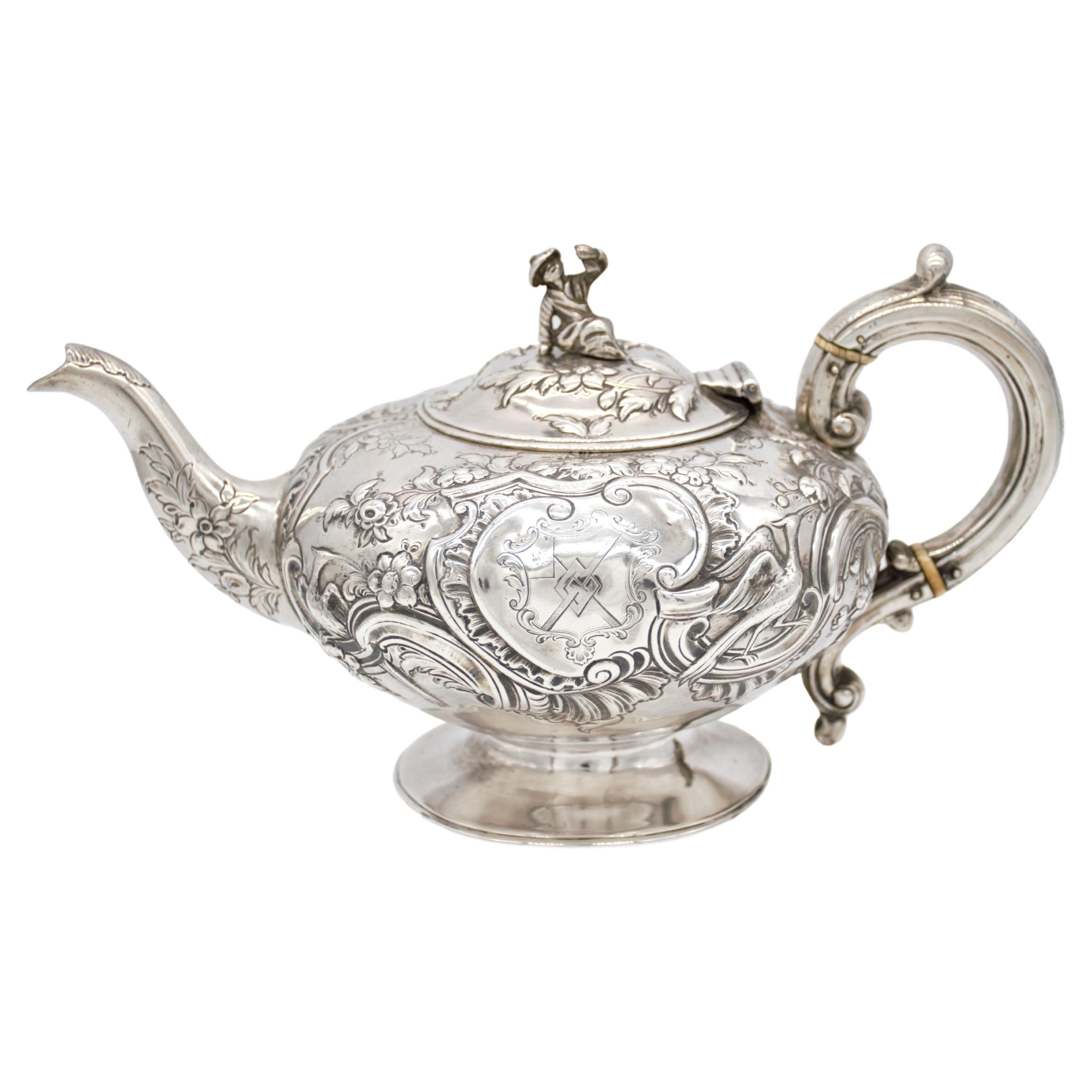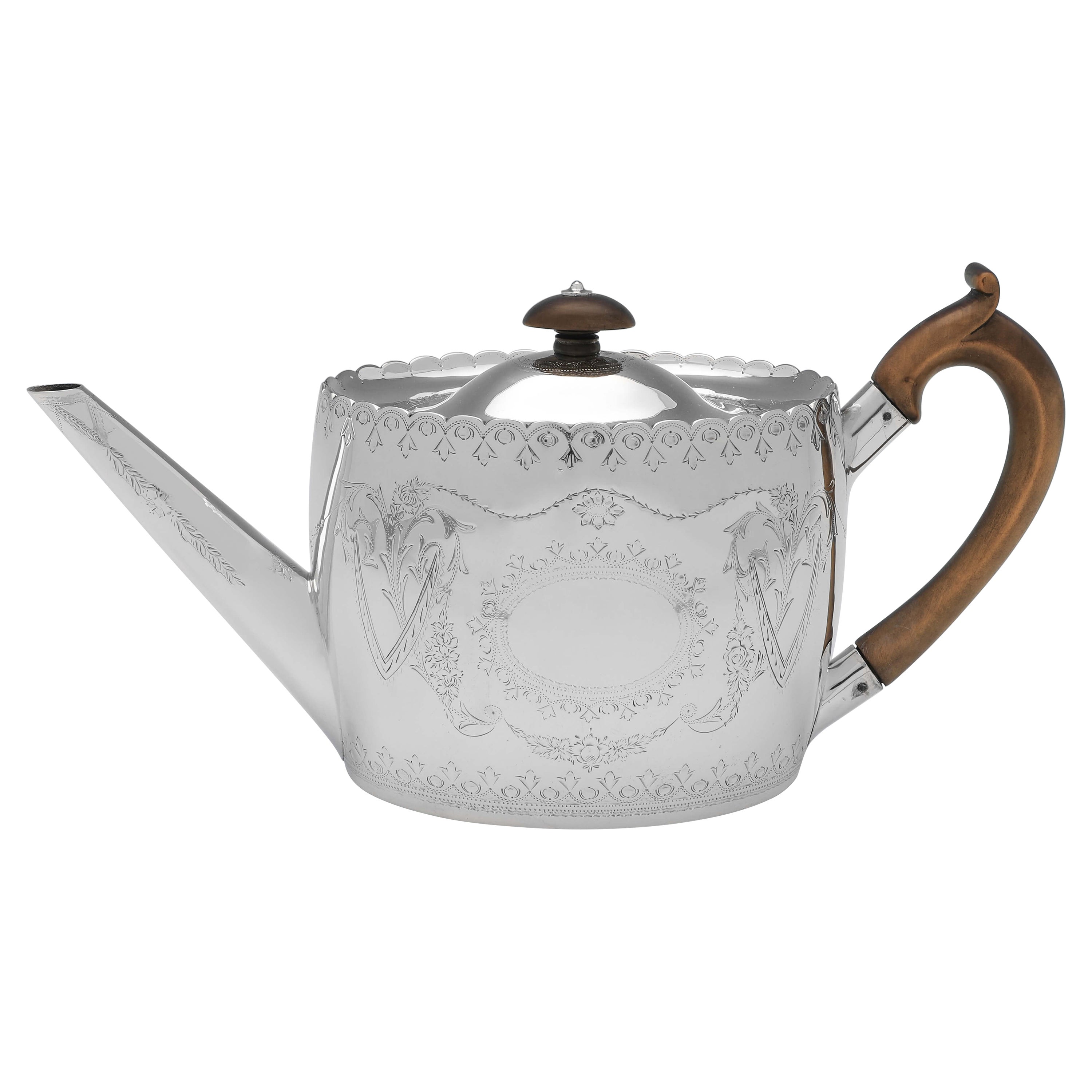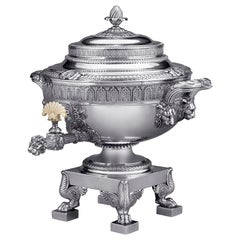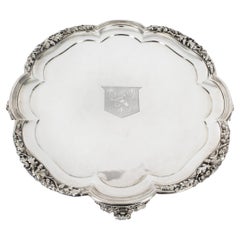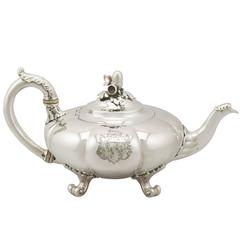
Antique William IV Sterling Silver Teapot by Paul Storr
View Similar Items
Antique William IV Sterling Silver Teapot by Paul Storr
About the Item
- Creator:Paul Storr (Maker)
- Dimensions:Height: 5.5 in (13.97 cm)Width: 6.1 in (15.5 cm)Depth: 10.9 in (27.69 cm)
- Style:William IV (Of the Period)
- Materials and Techniques:
- Place of Origin:
- Period:
- Date of Manufacture:1836
- Condition:Please see the main description for more details.
- Seller Location:Jesmond, GB
- Reference Number:Seller: A75611stDibs: LU120027228993
Paul Storr
Paul Storr was an English goldsmith and silversmith working in the Neoclassical and other styles during the late 18th and early 19th centuries. His works range from simple tableware to magnificent sculptural pieces made for royalty. Storr is credited with perfecting the works, styles and designs of the Regency period. His legacy is a remarkable body of work that spans over several stylistic periods with far-reaching influences. From his Neo-classical masterpieces to his exuberant, ornate vessels, Storr imparted a level of craftsmanship and superior quality that has seldom been seen since.
- Antique Victorian Sterling Silver TeapotBy Charles Reily & George StorerLocated in Jesmond, Newcastle Upon TyneAn exceptional, fine and impressive antique Victorian English sterling silver teapot; an addition to our silver teaware collection This exce...Category
Antique 19th Century English Victorian Tea Sets
MaterialsSilver, Sterling Silver
- Antique Georgian Sterling Silver Bachelor TeapotLocated in Jesmond, Newcastle Upon TyneAn exceptional, fine and impressive antique George III English sterling silver bachelor teapot; an addition to our Georgian silver teaware collection This exceptional antique Edwardian sterling silver teapot has an inverted pear shaped form onto a circular spreading foot. The surface of the bachelor teapot is plain and unembellished. The upper rim of the body is ornamented with a band of cast and applied gadroon decoration all in a swirl design. This antique silver teapot is fitted with a hallmarked, domed flush hinged cover surmounted with an impressive and original, cast sterling silver flame style finial; the flush hinge indicates the high quality of the piece. This exceptional example of antique teaware retains the original C scroll carved painted wood handle featuring a plain scrolling thumbpiece and a cast silver leaf decorated design to the upper socket, This impressive example of antique silverware has a cast silver swan necked spout embellished with fluted decoration and applied leaf motif to the lip. The ornamentation to the underside of the spout incorporates a vacant oval cartouche below a shell motif. The cast circular spreading foot is encircled with further gadroon decoration to the rim. Note: This maker may have been recorded in the missing 1739-1758 Smallworkers' Register or the 1758-1773 Largeworkers' Register, determining this maker's mark to be classed as 'unidentified' in all documents. The mark has been discovered on other holloware items such as mugs, salts and sauce boats. Condition This antique silver teapot for one...Category
Antique 18th Century English George III Sterling Silver
MaterialsSilver, Sterling Silver
- Antique Sterling Silver Gilt Beaker by Paul StorrBy Paul StorrLocated in Jesmond, Newcastle Upon TyneAn exceptional, fine and impressive antique English sterling silver gilt beaker made by Paul Storr; an addition to our continental silverware collection. ...Category
Antique 1830s British Sterling Silver
MaterialsSterling Silver
- Paul Storr Antique Georgian Sterling Silver SaltsBy Paul StorrLocated in Jesmond, Newcastle Upon TyneAn exceptional, fine and impressive set of three antique Georgian English sterling silver salts made by Paul Storr; an addition to our silver cruet and condiment collection. These...Category
Antique 1810s British George III Sterling Silver
MaterialsSilver, Sterling Silver
- Antique Edwardian Sterling Silver Teapot Queen Anne StyleBy W.G. Keight 1Located in Jesmond, Newcastle Upon TyneA fine and impressive antique Edwardian English sterling silver teapot in the Queen Anne style, part of our diverse teaware collection. This impressive antique Edwardian sterling silver teapot has been modelled in the Queen Anne style onto an oval collet foot. The lower portion of this fine teapot is embellished with batwing style embossed fluted decoration accented with subtly elevated rounded projections. The upper portion of the body is encircled with a narrow band reflecting the same fluted decoration, all in a swirl design. The Edwardian teapot is fitted with a hinged domed cover, which features further fluted decoration. The cover is surmounted by a carved, shaped fluted painted wood and sterling silver finial. This Queen Anne style teapot...Category
Antique Early 1900s English Queen Anne Sterling Silver
MaterialsSilver, Sterling Silver
- Elkington & Co. Vintage Sterling Silver TeapotBy Elkington & Co.Located in Jesmond, Newcastle Upon TyneAn exceptional, fine and impressive vintage Elizabeth II English sterling silver teapot made in the George I style; an addition to the silver teaware collection. This exceptional Elizabeth II English sterling silver teapot has a plain oval rounded form onto an oval domed spreading foot, in the Classic George I style. The surface of this vintage silver teapot...Category
Vintage 1960s English George I Sterling Silver
MaterialsSterling Silver
- 19th Century Paul Storr Silver Tea UrnBy Rundell, Bridge & Rundell, Paul StorrLocated in New Orleans, LAThis extraordinarily rare and masterfully crafted tea urn is by the hand of the master Georgian silversmith Paul Storr. Created by Storr while working for Rundell, Bridge and Rundell, Jewelers and Goldsmiths to the King, this magnificent piece truly represents the sophisticated style of the renowned firm and the enormous talents of Paul Storr. Applied and engraved decoration envelop this masterpiece equipped with a carved handle, lion's head spigot and spectacular lion's paw supports. The piece bears the arms of the Neave Baronetcy with those of Digby, for Sir Thomas Neave and his wife Frances Caroline, daughter of the Hon. William Digby, the Dean of Durham. Though he held no formal title, Storr enjoyed patronage from the most important and powerful figures of the period including King George III and the Prince of Wales, the future King George IV. His first major work was a gold font commissioned by the Duke of Portland in 1797, and in 1799 he created the “Battle of the Nile...Category
Antique 19th Century English Georgian Sterling Silver
MaterialsSilver
- Antique Large William IV Silver Tray Salver by Paul Storr 1820 19th CenturyBy Paul StorrLocated in London, GBThis is a wonderful English antique William IV sterling silver tray, or salver, by the world famous silversmith Paul Storr. It has clear hallmarks for London 1820 the makers mark of Paul Storr. It is typical of his work with the octafoil shape and the exquisitely detailed reeded rim, and it is raised on four delightful foliate and scroll feet. The centre is engraved with a shield shaped coat of arms which I have had researched. The Marital Arms of Knollis and Hallifax The armorial bearings as engraved upon this George IV Large English Sterling Silver Footed Salver by Paul Storr hallmarked London 1820 are those of the family of Knollis with Hallifax in pretence. These armorial bearings denote the marshalling of a marital coat showing the arms of the husband over the entire surface of the shield, whilst the arms of the wife (as an heraldic heiress) are placed on a small shield (known as an escutcheon of pretence) centrally on the husband’s arms. They may be blazoned as follows: Arms: Quarterly 1st and 4th Azure crusily of cross crosslets a cross moline voided or (for Knollys) 2nd and 3rd Gules on a chevron argent three roses of the field barbed proper (for Knollys) over all an escutcheon of pretence Or on a pile engrailed sable between two fountains barry wavy of six argent and azure three cross crosslets of the first (for Hallifax) Crest: An elephant argent [differenced with a mullet1 ] (for Knollys) Motto: In utrumque paratus [Prepared for either] (for Knollys) These armorial bearings undoubtedly commemorate the marriage of The Honourable and Reverend Francis Knollis2 (baptised 3rd January 1743 died 27th February 1826), 1 The cadency mark for a third son of a family. 2 Francis appears to have preferred this spelling of his family’s surname. It is spelt as it is to be pronounced. of Burford in the County of Oxfordshire and of Eastleach Martin in the County of Gloucestershire and Mary Hallifax (baptised 5th March 1753 buried 18th December 1830). Francis and Mary were married at the Parish Church of St Mary, Ewell in the County of Surrey on the 9th June 1772. Francis was the third son of Charles Knollys (the titular 5th Earl of Banbury) 3 and his wife, Martha Hughes, whilst Mary was the daughter of The Reverend James Hallifax, of Ewell aforesaid and his wife, Elizabeth Chardavoyn. 3 Francis’s father claimed to be the 5th Earl of Banbury. A claim that continued to be pursued by the family until William Knollys, the titular 8th Earl of Banbury (born 1763 died 1834) was forced to discontinue its use by a resolution of the House of Lords which rejected his claim to the earldom in 1813. The crest surmounts a detailed dedication: This piece of plate was presented to the Honourable Rev Knolls by the inhabitants of the town and immediate neighbourhood of Burford on his completing the fiftieth year of his incumbency as the vicar of Burford. In testimony of their high respect 11th April 1821 There is no mistaking its unique quality and design, which is sure to make it a treasured piece by any discerning collector. Condition: In excellent condition with clear hallmarks and no dings, dents or signs of repair. Please see photos for confirmation. Dimensions in cm: Height 3 x Width 36 x Depth 36 Weight 1.52 kg Dimensions in inches: Height 1 inch x Width 1 foot, 2 inches x Depth 1 foot, 2 inches Weight 49 troy oz Paul Storr born in London England in 1771, was to become one of the most talented silversmiths of the nineteenth century. Today his legacy of exceptionally well crafted silver, found worldwide in museums and private collections, leaves one in awe when compared to that of his contemporaries.After having served a seven year apprenticeship from the age of 14, he began his career in 1792 when he went into a brief partnership with William Frisbee. This did not last and in 1793 a new mark, (his initials ‘P S’) was entered. By the beginning of the nineteenth century he had established himself as one of London’s top silversmiths producing, amongst others, commissions for Royalty. In 1801 he married Elizabeth Susanna Beyer with whom he was to have ten children. In 1807 Paul Storr entered into a working relationship with Philip Rundell and by 1811 was a partner, and managing the workshops for Rundell, Bridge & Rundell. During this period he kept his own marks and separate workshop. However it was through Rundell, Bridge & Rundell who were appointed Goldsmith in Ordinary to George III in 1804 that his reputation as a master silversmith grew. His talents lay in being able to transform ideas and designs from Rundell, Bridge & Rundell’s designers, William Theed...Category
Antique 1820s English William IV Sterling Silver
MaterialsSterling Silver
- Antique Large William IV Silver Tray Salver by Paul Storr 1837 19th CenturyBy Paul StorrLocated in London, GBThis is a wonderful English antique William IV sterling silver tray, or salver, by the world famous silversmith Paul Storr. It has clear hallmarks for London 1837 the makers mark of Paul Storr and is also engraved Storr & Mortimer 36, they were Goldsmiths and Jewellers to Her Majesty’ (1822-1839). It is typical of his work with the octafoil shape and the exquisitely detailed foliate and acorn rim. It is raised on four delightful foliate and scroll feet. The centre is engraved with a shield shaped coat of arms encompassing the lion rampant which I have had researched: The Arms of the Family of King The arms as engraved upon this William IV English Sterling Silver Footed Salver by Paul Storr hallmarked London 1837 are those of the family of King. They may be blazoned as follows: Arms: Sable a lion rampant between three crosses formy fitchy argent Undoubtedly this salver was in the possession of a gentleman who was member of a family bearing the name of King. There are a number of variants of these armorial bearings being borne by King families. Very often the lion is of a different tincture but the field of the shield is invariably remains ‘sable’. Similar arms and crest were recorded by Sir Edward Bysshe, Clarenceux King of Arms in his Visitation of the County of Kent of 1663 to the family of King, of Bromley. The tinctures of both arms and crest of King, of Bromley were slightly different to those engraved upon this tureen in that the Visitation family’s arms were ‘Sable a lion rampant ermine between three crosses paty fitchy or’ 1 and the crest ‘A lion’s gamb erect and erased sable holding a cross paty fitchy or’(see illustration below). These arms and crest were granted by Sir Edward Walker, Garter King of Arms on the 20th February 1660 – 61; and yet another Kentish family of King, of Bellevue who were created Baronets within the Baronetage of Great Britain in 1792 bore for their arms ‘Sable a lion rampant erminois between three crosses paty fitchy or’. Their crest being the same as the family of King, of Bromley. There is no mistaking its unique quality and design, which is sure to make it a treasured piece by any discerning collector. Please see potos of the 2nd Baronet Timothy Shelley, 1753-1844 and Castle Goring, his home. Condition: In excellent condition with clear hallmarks and no dings, dents or signs of repair. Please see photos for confirmation. Dimensions in cm: height 4 x width 44 x depth 44 Weight 1.96 kg Dimensions in inches: height 2 inches x width 1 foot, 5 inches x depth 1 foot, 5 inches Weight 63 troy oz Paul Storr born in London England in 1771, was to become one of the most talented silversmiths of the nineteenth century. Today his legacy of exceptionally well crafted silver, found worldwide in museums and private collections, leaves one in awe when compared to that of his contemporaries.After having served a seven year apprenticeship from the age of 14, he began his career in 1792 when he went into a brief partnership with William Frisbee. This did not last and in 1793 a new mark, (his initials ‘P S’) was entered. By the beginning of the nineteenth century he had established himself as one of London’s top silversmiths producing, amongst others, commissions for Royalty. In 1801 he married Elizabeth Susanna Beyer with whom he was to have ten children. In 1807 Paul Storr entered into a working relationship with Philip Rundell and by 1811 was a partner, and managing the workshops for Rundell, Bridge & Rundell. During this period he kept his own marks and separate workshop. However it was through Rundell, Bridge & Rundell who were appointed Goldsmith in Ordinary to George III in 1804 that his reputation as a master silversmith grew. His talents lay in being able to transform ideas and designs from Rundell, Bridge & Rundell’s designers, William Theed...Category
Antique 1830s English William IV Sterling Silver
MaterialsSterling Silver
- Antique Rare Georgian Sterling Silver Teapot by Paul Storr 1817, 19th CenturyBy Paul StorrLocated in London, GBThis is an exceptional and very rare antique English George III sterling silver teapot by the world-famous silversmith, Paul Storr, and bearing hallmarks for 1817. This splendid teapot is of a delightful shape and it is profusely chased with half ribbed fluting decoration. It is further embellished with wonderful foliate motifs below and above the spout and stunning gadrooned shaped borders to the top of the teapot and the base. The remarkable quality flush hinged lid is also beautifully surmounted by a delightful round finial. It features an exceptional horn handle with striking details, proving the silversmith's exceptional mastery in the creation of unique and luxurious silverware - Paul Storr never tired of adding detail to create a true piece of artwork. The underside of the teapot bear full hallmarks: the Lion passant for sterling silver, the leopard head for London, the letter for 1817 and the maker's marks 'PS' for Paul Storr. There is no mistaking its unique quality and design, which is sure to make it a treasured piece by any discerning collector. Condition: In excellent condition with clear hallmarks and no dings, dents or signs of repair. Please see photos for confirmation. Dimensions in cm: height 12.5 x width 18 x depth 18 Weight 0.88 kg Dimensions in inches: height 5 inches x width 7 inches x depth 7 inches Weight 28.2 troy oz Paul Storr born in London England in 1771, was to become one of the most talented silversmiths of the nineteenth century. Today his legacy of exceptionally well crafted silver, found worldwide in museums and private collections, leaves one in awe when compared to that of his contemporaries.After having served a seven year apprenticeship from the age of 14, he began his career in 1792 when he went into a brief partnership with William Frisbee. This did not last and in 1793 a new mark, (his initials ‘P S’) was entered. By the beginning of the nineteenth century he had established himself as one of London’s top silversmiths producing, amongst others, commissions for Royalty. In 1801 he married Elizabeth Susanna Beyer with whom he was to have ten children. In 1807 Paul Storr entered into a working relationship with Philip Rundell and by 1811 was a partner, and managing the workshops for Rundell, Bridge & Rundell. During this period he kept his own marks and separate workshop. However it was through Rundell, Bridge & Rundell who were appointed Goldsmith in Ordinary to George III in 1804 that his reputation as a master silversmith grew. His talents lay in being able to transform ideas and designs from Rundell, Bridge & Rundell’s designers, William Theed...Category
Antique 1810s English George III Sterling Silver
MaterialsSterling Silver
- Antique Sterling 925/°°° Silver Finely Chased TeapotLocated in Torino, ITManufactured by Charles Wright, London, England, 1771.Category
Antique 1770s English Sterling Silver
MaterialsSterling Silver
- exceptional George III teapot by preeminent silversmith Paul Storr, 1793By Paul StorrLocated in Tel Aviv - Jaffa, ILThis rare and exceptional George III teapot is the work of preeminent Georgian silversmith Paul Storr, it is one of his earliest works, the date mark on this pieces of the year 1793 which is the first year Storr marked items with his own initials (P S) The teapot is designed in the neoclassical taste with some Chinese influences, or Chinoiserie taste, even the figure on the cover of the teapot is Chinese. It is very hard to impossible to find works from this early period with this interesting Royalty provenance. The family crest on the front is of the Tollemache family, and dating of The teapot indicate It belonged and probably commissioned by or as a gift to William Manners Tollemache, Lord Huntingtower, William, On 12 January 1793, at the Age of 26, he Was created a Baronet, of Hanby Hall in the County of Lincoln. So this teapot was commissioned to celebrate the occasion. William Manners Tollemache: Lord Huntingtower (19 May 1766 – 11 March 1833), known as Sir William Manners, Bt, between 1793 and 1821, was a British nobleman And Tory politician. Born William Manners, he was the eldest son of John Manners and Louisa Tollemache, 7th Countess of Dysart. On 12 January 1793, at the age of 26, he was Ceated a Baronet, of Hanby Hall in the County of Lincoln.On his mother's Succession to the earldom in 1821, he was styled Lord Huntingtower, and adopted The surname of Talmash or Tollemache Paul Storr: (baptised 28 October 1770 in London – 18 March 1844 in London) was an English goldsmith and silversmith working in the Neoclassical and other styles During the late eighteenth and early nineteenth centuries. His works range from Simple tableware to magnificent sculptural pieces made for royalty Paul Storr was England's most celebrated silversmith during the first half of the Nineteenth century and his legacy lives on today. His pieces historically and Currently adorn royal palaces and the finest stately homes throughout Europe and The world. Storr's reputation rests on his mastery of the grandiose neo-Classical Style developed in the Regency period. He quickly became the most prominent Silversmith of the nineteenth century, producing much of the silver purchased by King George III and King George IV. Storr entered his first mark in the first part of 1792, which reflects his short-lived partnership with William Frisbee. Soon after, he Began to use his PS mark, which he maintained throughout his career with only Minor changes. His first major work was a gold font commissioned by the Duke of Portland...Category
Antique 1790s English Neoclassical Tea Sets
MaterialsSilver
